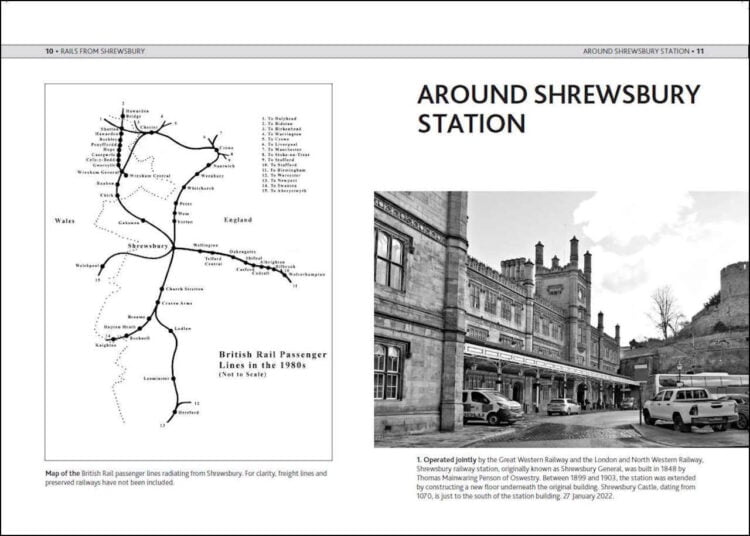This hardback book published in November 2023 by Pen & Sword and written by Peter J Green measures around 24.6 cm x 17.3 cm, and has 208 pages and 266 black and white illustrations. It has a published price of £25, but at the time of writing it can be obtained from Amazon for £19.02.
The geographical location of Shrewsbury made it a natural focus for railway enthusiasts, as it was the junction of the lines from Chester, Crewe, Wolverhampton, Hereford, and Aberystwyth. Unlike much of the rest of the country, many train movements are still controlled by semaphore signals, and these, as well as their controlling signal boxes, are seen in many of the book's photographs.
Shrewsbury is also the home of Severn Bridge Junction, which is the largest remaining operational mechanical signal box in the world, but unfortunately it features in only one photograph.
The book's title suggests that its focus is on Shrewsbury itself, but over half the photographs cover lines beyond the general environs of the city. I was surprised to find that the author had included sections on the preserved railways at Llangollen, Telford, the Severn Valley, the Welshpool and Llanfair, Cambrian Heritage Railway at Oswestry, and even the Glyn Valley Tramway.
There is a good variety of photographs showing much of the general railway infrastructure and mechanical signalling still in use in the area, and a well-chosen selection showing locomotive-hauled trains of most classes that were familiar sights at the time.
The book is not divided into chapters but has 23 sections starting with a map of lines from Shrewsbury and photos around Shrewsbury station and to Gobowen, followed by: lines from Gobowen and Wrexham; Shrewsbury to Crewe and Wellington; lines from Wellington and Madeley Junction; Shrewsbury to Abbey, Welshpool, and Craven Arms; lines from Craven Arms; a section on steam-hauled special trains; and concludes with preserved railways at Llangollen, Telford, the Severn Valley and The Welshpool and Llanfair.
The map at the beginning of the book and seen below is clear and shows the large area covered by the book, where Shrewsbury can clearly be seen as the focus of operations. The photo on the right shows that, unlike so many stations where their outstanding architecture has been swept away in the name of so-called progress, such ruination hasn't occurred at Shrewsbury.

The photos below bring back memories of short parcel trains, loco-hauled passenger trains, and first-generation diesel multiple units. The right-hand page below shows the impressive structure that is the Severn Valley Junction Signal Box.
Many of the lines radiating from Shrewsbury are still controlled by mechanical signal boxes, such as the ones seen below on the line from Shrewsbury to Gobowen.
Although at first sight, the line from Wrexham General to Chester would seem to fall outside the book's remit, they provide a natural extension to the section covering the line from Shrewsbury to Wrexham General.
The pages below will bring back memories for anyone who was familiar with the Welsh Marches line from Shrewsbury to Hereford in the age of steam when LMS Jubilees and Black 5s and GWR Castles reigned supreme on passenger services over the North and West route.
The years covered by the book start from just after the end of steam and there are enough photos from that era to satisfy the harshest critic. What stands out is the amount of semaphore signalling that still exists in the area, shown by the variety of signal boxes and semaphore signals illustrated.
I was surprised that all photographs were in black and white, as undoubtedly many of the originals had been taken in colour. However, many purists much prefer that format for railway photography, and overall the book does not suffer from the lack of colour.
In the years of steam, Shrewsbury was noted as a place where Great Western Railway Kings could be seen alongside London, Midland and Scottish Pacifics. Although the book does not include any such locomotives at Shrewsbury itself, the section on steam-hauled specials allows nostalgia to take over with views of special trains featuring LMS Pacific Princess Elizabeth and GWR King Class King George V.
This is an eye-opening book that, besides illustrating the myriad of lines serving Shrewsbury, it also highlights just how much steam-age railway infrastructure still exists. Highly recommended.
The book is available to purchase from Amazon and from Pen & Sword.
We would like to thank Pen & Sword for providing RailAdvent with a copy of the book for review.